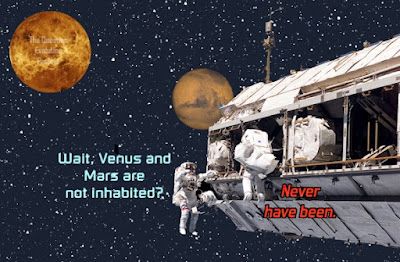Venus and Mars are not Right for Life
Although none of the hypotheses trotted out to explain the origin of the solar system are successful, the flawed nebular hypothesis (accretion) is the best of the worst, so that is what secular cosmologists use. It also brings additional problems and raises numerous questions.
That big swirl supposedly formed the sun and all the planets. Although Venus, Earth, and Mars have superficial similarities, there are several important differences. Venus has an extremely slow rotation, and runs the opposite of the other planets, for one.
 |
| Includes images from NASA, especially STS-116 (usage does not imply endorsement of site contents) |
It would seem that Mercury, that rock closest to the sun, would be the hottest planet. Venus is far hotter because of trapped heat from greenhouse gasses. Secularists want to know why, but thwart themselves from getting real answers by presupposing a faulty origin of the universe — also, by fanatically believing in and assuming evolution.
Hope for finding life there is unjustified and diminishing all the time. They even thought there were stinky microbes in the atmosphere that indicated life forms, but that was just chasing the wind. Since the desire to find extraterrestrial life is so important to materialists, some took a notion that if we learn about Venus, we can learn about why Earth is different, and about life around other stars. This also shows some of the naturalistic underpinning of global warming alarmism — materialistic deep-time presuppositions.
Yet evolutionists believe Venus might have once looked much like Earth today. At one point, they think, Venus might have had a little more curb appeal, possibly with oceans and a kinder temperature. Maybe, in a brief billion-year window, life might have evolved on Venus. But then Venus let itself go.
The evolutionary model requires that in the early solar system almost 4.5 billion years ago, the sun was nearly 40% fainter than it is today. But this presents a problem for the Earth. With a fainter sun, if all else were the same, Earth would have ended up an ice world, a condition from which our planet probably could not have recovered. Astronomers call this the faint young sun “paradox.” So how do evolutionists explain why Earth remains inhabitable today? Their most common solution is that the early Earth had more greenhouse gases than it has today.
To read all of this article, fly on over to "Venus: Earth’s Noxious Neighbor." After you read about Venus, come back for information on Mars, alright?
Speculations of life on the red planet have been around for a mighty long time, and these have been fodder for a Conestoga wagon-full of science fiction stories. This child finds it quite interesting that H.G. Wells wrote The War of the Worlds in 1898, and used that Victorian myth of the nebular hypothesis and some other things, a slurry of science fact, error, and speculation. Many of these things are still active today. (For fun, take a look-see at the first few paragraphs.) Years ago, there was enough data for scientists to make the declaration about Martian life: "Ain't no way." As seen in recent years, there are attempts to find life there anyway.
Although many in the secular science industry are gullible and dishonest, seeking to have their biases confirmed about evolution, a few urge caution. There have been apparent biosignatures many times in the past, only to be discovered that they were look-alikes and no life left signatures. No need to be crying "Martian wolf!" and getting folks all het up over nothing.
Really, is it reasonable to expect to find life elsewhere? Over and over we have seen that Earth is uniquely designed for life, and all other attempts to find life extraterrestrial life have had the wheels come off. Our designer made the Earth for us (Isaiah 45:18), and some of us are not surprised that all those searches for extraterrestrial life come up empty. Also, some of us are a bit disappointed in the huge waste of tax money and resources, too.
McMahon and Cosmidis have a message for astrobiologists: Hold yer horses. “It is often acknowledged that the search for life on Mars might produce false positive results, particularly via the detection of objects, patterns or substances that resemble the products of life in some way but are not biogenic,” they caution. “The success of major current and forthcoming rover missions now calls for significant efforts to mitigate this risk” [of galloping toward mirages]. It’s true these are “exciting times for astrobiology,” they continue, but they worry about adding to the difficulties of finding life that have continued to “plague paleontology” for many years.
The entire article is stationed at "Mars Life Is a Mirage."